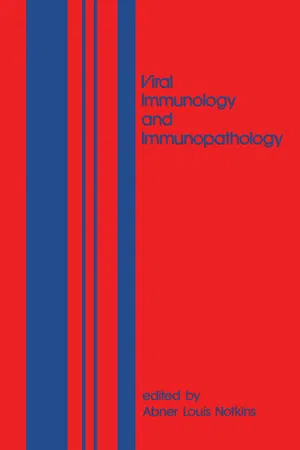
- 496 pages
- English
- ePUB (mobile friendly)
- Available on iOS & Android
Viral Immunology and Immunopathology
About This Book
Viral Immunology and Immunopathalogy covers topics concerning the role of cellular and humoral immunity in viral infections, factors responsible for the persistence and recurrence of viral infections in the presence of immunity, mechanisms of viral immunopathology, and concepts in the development of vaccines. The book describes the history of viral immunology; the synthesis and properties of viral antigens; and the humoral immune response to viruses. The text also discusses the mechanisms of viral neutralization; cellular immunity; the role of inflammatory cells and effector molecules in combating viral infections; and the genetic control of resistance. The book concludes with chapters on herd immunity; viral immunopathology; and viral immunology and immunopathology. Immunologists, pathologists, virologists, and microbiologists will find the book useful.
Frequently asked questions
Information
HISTORY OF VIRAL IMMUNOLOGY
Publisher Summary
INTRODUCTION
THE CONCEPT OF VIRUS
Table of contents
- Cover image
- Title page
- Table of Contents
- Copyright
- Authors and Participants
- Preface
- Chapter 1: HISTORY OF VIRAL IMMUNOLOGY
- Chapter 2: VIRAL REPLICATION
- Chapter 3: VIRAL ANTIGENS
- Chapter 4: HUMORAL IMMUNE RESPONSE TO VIRAL INFECTIONS
- Chapter 5: MECHANISMS OF VIRAL NEUTRALIZATION
- Chapter 6: DESTRUCTION OF VIRUS-INFECTED CELLS BY ANTIBODY AND COMPLEMENT
- Chapter 7: CELL-MEDIATED IMMUNITY IN VIRAL INFECTIONS
- Chapter 8: THE ROLE OF THE INFLAMMATORY RESPONSE IN VIRAL INFECTIONS
- Chapter 9: INTERFERON AS A MEDIATOR OF CELLULAR IMMUNITY IN VIRAL INFECTIONS
- Chapter 10: GENETIC CONTROL OF RESISTANCE TO VIRAL INFECTION IN MICE
- Chapter 11: PERSISTENCE OF VIRAL INFECTION IN THE PRESENCE OF IMMUNITY
- Chapter 12: RADIOIMMUNOASSAYS FOR DETECTION OF VIRAL ANTIGENS AND ANTIVIRAL ANTIBODY
- Chapter 13: IMMUNE RESPONSE TO HEPATITIS VIRUSES
- Chapter 14: IMMUNE RESPONSE TO LEUKEMIA VIRUSES IN MICE
- Chapter 15: IMMUNE RESPONSES TO EPSTEIN-BARR VIRUS
- Chapter 16: HERD IMMUNITY – CHANGING CONCEPTS
- Chapter 17: CURRENT APPROACHES TO VIRAL IMMUNOPROPHYLAXIS
- Chapter 18: SUBUNIT VIRAL VACCINES
- Chapter 19: ADVERSE EFFECTS OF VIRAL VACCINES
- Chapter 20: IMMUNE COMPLEX DISEASE ASSOCIATED WITH VIRAL INFECTIONS
- Chapter 21: VIRUS-INDUCED CELL-MEDIATED IMMUNOPATHOLOGICAL DISEASE
- Chapter 22: THE EFFECT OF VIRAL INFECTIONS ON THE FUNCTION OF THE IMMUNE SYSTEM
- Chapter 23: AUTOIMMUNITY IN VIRAL INFECTIONS
- Chapter 24: THE FUTURE IN VIRAL IMMUNOLOGY AND IMMUNOPATHOLOGY
- APPENDIX: WORKSHOP ON VIRAL IMMUNOLOGY AND IMMUNOPATHOLOGY
- APPENDIX: SUMMARY OF WORKSHOP
- Subject Index